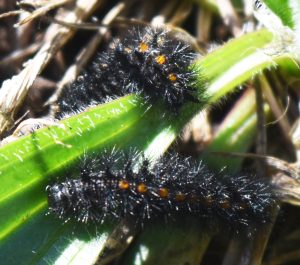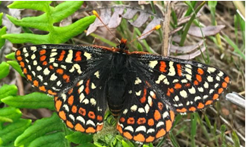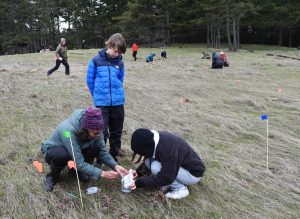Beautiful Butterflies in Helliwell Provincial Park
Categories:

In March 2022, BC Parks and the Taylor’s Checkerspot Butterfly Recovery Project released a record 5,400 Taylor’s Checkerspot butterfly larvae in Helliwell’s coastal bluff meadow over a three-week period. There is great hope that this will give a big boost to establishing a self-sustaining population.
In 2020, 800 larvae (also known as caterpillars) were released, and in 2021, 1,300 larvae. The caterpillars were reared at the Greater Vancouver Zoo with the support of Wildlife Preservation Canada staff. A minimum of 5,000 larvae per year seems to be an important factor for successful butterfly reintroductions, because that will usually result in about 250 adult butterflies each year.
Multiple partners have been involved over the last three years to re-establish a population of the critically endangered species in Helliwell Provincial Park. The project team had a lot of help to gently place all those fuzzy little larvae on their meadow food plants with assistance from: K’ómoks First Nation, Greater Vancouver Zoo, BC Conservation Foundation, Mosaic Forest Management, Conservancy Hornby Island, the Hornby Island Natural History Centre, Hornby Island Provincial Parks Committee and BC Parks.


Trampling is a key threat for caterpillars and their food plants, which include leaves of English plantain, small-flowered blue-eyed Mary, or harsh paintbrush. Park visitors can help protect the caterpillars by staying on the trails that are delineated by ropes and restoration area signs. Also, visitors are reminded that dogs must be on a leash and bikes aren’t allowed in this park.
The recovery initiative required extensive habitat restoration in the park, such as selective tree and invasive plant removal, and adding native plants and seeds. Although focused on Taylor’s checkerspot butterflies, several other at-risk and uncommon coastal bluff species benefit from this project, such as dun skipper butterflies and about a dozen other range-restricted butterflies, western bumble bee, bats, western screech-owl, and numerous other birds and plants.
If all goes well, the Taylor’s checkerspot butterflies will progress through a few more developmental stages, pupate, and then emerge as spectacular orange, black and white checkered butterflies in late April to early June.

If you spot a Taylor’s checkerspot, leave it be, and report sightings to Taylors.Checkerspot@gov.bc.ca, or by using the free iNaturalist app. It’s an easy-to-use species identification tool that enables citizen scientists to record and contribute important species data for projects around the globe.
This recovery project has benefited from funding from the BC Parks Licence Plate Program, the Habitat Conservation Trust Foundation, and the Environment Canada Habitat Stewardship Fund and others.
The Taylor’s Checkerspot Butterfly Recovery Project Team includes representatives from BC Ministry of Land, Water and Resource Stewardship, BC Ministry of Environment and Climate Change Strategy, BC Parks, biological consultants, Denman Conservancy Association, Garry Oak Ecosystems Recovery Team, Greater Vancouver Zoo, Mosaic Forest Management, Wildlife Preservation Canada, and others. There has also been a lot of local assistance for the project from Helliwell Park neighbours in High Salal Ranch Strata and local community volunteers. BC Parks and the project team thank the Cowichan Tribes, Halalt, Homalco, K’ómoks, Lake Cowichan, Lyackson, Penelakut, Qualicum, Snaw’Naw’As, Stz’uminus, Tla’amin, We Wai Kai, and We Wai Kum First Nations, for allowing us to restore ecosystems in their traditional territories.
Background Information
Taylor’s Checkerspot Butterfly (Euphydryas editha taylori)
- Also known as Edith’s Checkerspot.
- Historical range was Hornby Island, southeastern Vancouver Island, Puget Trough and to the Willamette Valley in Oregon. In BC, they were once abundant at 10 sites in the Greater Victoria Area, one site each near Mill Bay and Comox, and sites on Hornby Island (including Helliwell Provincial Park).
- They were thought to have been extirpated (became locally extinct) from Canada by 2000 when no Taylor’s Checkerspots could be found in their last known sites on Hornby Island despite intensive searches. However, new populations were discovered on Denman Island in 2005 and near Campbell River in 2018.
- They are federally listed as Endangered (COSEWIC, SARA Schedule 1), and are on the BC Red list of at-risk species.
- Taylor’s Checkerspot butterflies need open sunny meadows where they can find suitable host plants (food for larvae and nectar producing flowers for adults), such as woolly sunflower, common camas, small-flowered blue-eyed Mary, wild strawberry, sea blush, and yarrow.
- Habitat loss, degradation and fragmentation are major factors in the species’ decline. For example, the meadows along the coastal bluffs in Helliwell Provincial Park became less suitable for butterflies due to invasions of non-native plants and encroaching forests.
- Habitat enhancement work (weeding, selective limbing +/or removal of conifers, re-planting and seeding with native species) has been ongoing in Helliwell Provincial Park for several years.




